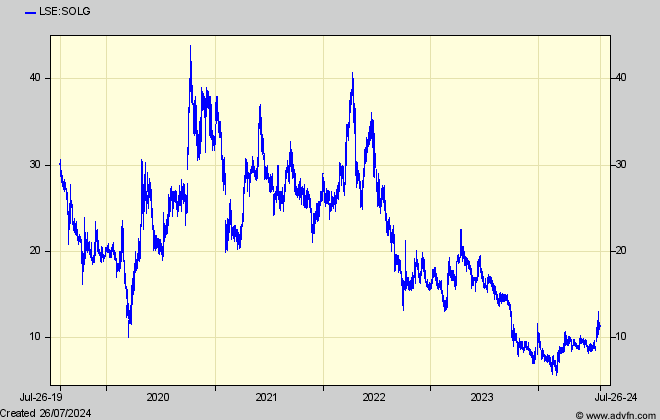Solgold Looking Much More Compelling

As I flagged last February Solgold’s value had to be unlocked somehow, and the 15 July streaming deal with Franco Nevada and Asisko has done just that. In return for putting up 42% of the estimated start-up capital for its proposed Cascabel mine in Ecuador,, they will take ‘only’ $1.5bn of the $32.3m life-of-mine revenue projected in the latest pre-feasibility study, which assumes gold and copper prices some 25% lower than prevailing now.
The deal is far better than I would have expected, but shows the key position ‘streaming’ companies like FNV, Wheaton Precious Metals, (and Trident Resources, now under offer) have built among miners to replace the more traditional sources of construction finance such as banks, institutional investors, and offtakers. And although ‘streaming’ (over the life of a mine) usually proves considerably more expensive than bank finance (especially if the commodity concerned rises in price, whose benefit is transferred from the producer to the streamer) it has the merit of avoiding the issue of equity shares by the mine owner and the resulting value dilution for shareholders.

It’s not yet a done deal because the $650m construction funds promised by FNV (plus another $100m working capital now) need to be supplemented by another $900m, which could come from traditional sources, so the risk of share dilution is still there. In other words it is a promise in advance of the normal ‘financial closing’ process when participants sign up to all pieces of the jigsaw – perhaps three years from now – to guarantee production will happen. In practice, Solgold thinks the additional funds will come as off-take deals for its copper concentrate, already proven as of the highest quality and of interest to smelters, so any further equity funding may not be necessary.
But the key to take from this deal is that predicting the eventual capital structure and therefore true share value of Solgold’s Cascabel project is now much easier and, more important, that a switch is likely from Solgold’s recent lowly rating at the hands of a retail market not interested in production eight years ahead and uncertain where capex will come from, to one dominated by the much broader picture seen by majors.
Speculation has always been that a bidder will eventually emerge for what will be a major long life copper asset. However, little sign of one over the last few years (resulting from previous Solgold mismanagement) has replaced that perception by near-certainty that Solgold will have to develop Cascabel itself, because a new owner would have had to persuade the current 3-4 major shareholders, while finding even the earlier and smaller $100m streaming deal with FNV unacceptable.
However, that new 42% cornerstone arriving now is a big, unexpected, endorsement of the project, and, as much more beneficial to Solgold than anyone expected, in my view makes a mining major bid for Cascabel (if not for Solgold) much more likely.
That is because majors looking to maintain their project flow have a much broader time scale and are willing to pay a lot more for a project than are investors in the shares. That was shown by Newmont willing to pay some 40% more than Newcrest’s market cap before its bid. Now, looking for a significant copper resource to take them into the 2040’s, majors will surely be running their slide-rules over the numbers thrown up by the Cascabel FNV deal, which does not dent the economics as badly as might have been feared.
The 2023 (revised) Preliminary Feasibility study showed a $3.2bn NPV at 8% over a 28 year mine life, requiring $1.6bn upfront capex. Running the numbers with the FNV stream assuming the remaining $900m capex on the same terms as its $650m, shows a reduction to a $2.9bn NPV – but on the ultra conservative $1,750/oz and $3.55/lb gold and copper prices assumed in the PFS.
At todays prices some 25% higher, that NPV is $1bn greater at $3.9bn (even after the extra 41% tax and royalties taken by the Ecuadorian Government) and is not the way an industry bidder will be looking at it.
That is because the PFS NPV is run ‘as of now’, and not as it will be when a decision to mine is made in three-four years time and capex is committed. By then, 3-4 years at a 8% discount rate will have been unwound while the capex a new owner will meet remains at $900m, so that his ‘as seen’ NPV to be earned after spending $900m will have risen by another 39%, from $4.8bn to $6.7bn. That is the after-tax discounted return a long-term Cascabel owner will see at present prices after meeting the $900m capex, (and, of course, the cost of his bid). The figures are before any inflation, which affects all parts of a NPV calculation and makes no difference to the gist of the argument.
(For interest, although not totally relevant, the total undiscounted after-tax free cash flow during Cascabel’s current planned 28 year life, at current metal prices will be over $15bn. So if a bidder uses a lower cost of capital than 8% or already has the cash, he will see a ‘value’ between $6.7bn and $15bn, and judge what he can pay to acquire it accordingly)
Investors in the shares, in contrast to a major taking the long view looking to add to his copper pipeline and investing in the project, won’t be looking at the numbers in that way, and will still be thinking delivery is too distant.
Another factor a bidder will appreciate is that half the total project cash flow is delivered in only the first 8 years (from the high grade porphyry core) meaning a lower long term risk. So I would be surprised if the present key mining shareholders – BHP and Newmont, each with 10%, and the Chinese Jianxi Copper with 6%, – or others (reportedly 20 in number) in the wings – are not looking hard and pondering a strategy to acquire Cascabel, if not Solgold as a whole.
Having said that, neither BHP nor Newmont have experience in Ecuador. Newmont however has operations in Chile and Peru; has expertise in block caves planned for Cascabel; and wants to increase its copper exposure (still less than 10% of its reserves) while running down its gold – from which it is divesting to raise some $2bn – half of which it plans to use to buy back its shares and the rest to increase its dividend.
But that $2bn would buy it Solgold’ s $450m current market cap and add 50% to its existing copper resources while funding the remaining $900m Cascabel capex, as well as getting all Solgold’s other promising Ecuadorian copper exploration portfolio. On the above numbers, it could afford to pay double or treble Solg’s current market cap, and still make a healthy long term profit. On top of it all it will have the cash, so won’t need to discount its – as seen – future returns, as does the PFS – making them look even better.
The same ‘as seen’ value considerations would apply for any other bidder of course, although I can’t see that BHP would have as big a motive to acquire Cascabel as does Newmont, even though rumours are that it is still interested. Its not for me to say. But maybe Solgold’s game-changer, and copper showing early signs of its long-expected surge, could persuade Newmont to rethink what to do with that $2bn. It has already started to buy back shares and to increase the dividend. But buy-back effectiveness can never be guaranteed, and shareholders might prefer Cascabel to a 2% extra dividend yield.
And all I discuss here completely ignores the potential from Solgold’s other significant projects in Ecuador which Solgold has said it is looking to finance either from jv’s or by spinning them, or Cascabel, off to shareholders.
Although held back by recent marker weakness the shares are holding up well, and buying some now looks a no-brainer to me.
Comments (0)